Abstract
Although women with breast cancer tend to have a greater proportion of their circulating oestradiol non-protein bound and albumin bound, and less SHBG-bound, than controls, it remains uncertain whether this has an aetiological role or is an effect of the tumour. Oestradiol and its binding to serum proteins was investigated: (a) in relation to risk factors for breast cancer in a normal population; (b) in women with proliferative benign breast disease as a risk group for breast cancer, and women with non-proliferative benign breast disease as a low risk group, as well as breast cancer patients. The strongest associations were with body mass index; the greater the body mass the greater the bioavailability of oestradiol. Changes in relation to age at menarche and menopause could have been a function of body mass. An interesting change with age was noted with a fall in bioavailability over the menopausal years. There was no relationship apparent for parity, age at first full term pregnancy, family history or country of birth. Similar differences in oestradiol binding between cases and controls were seen for patients with breast cancer, benign epithelial hyperplasia and fibrocystic disease without proliferative changes, but these were not significant. This study provides limited support for the concept that oestradiol binding has an aetiological role in the development of breast cancer.
Full text
PDF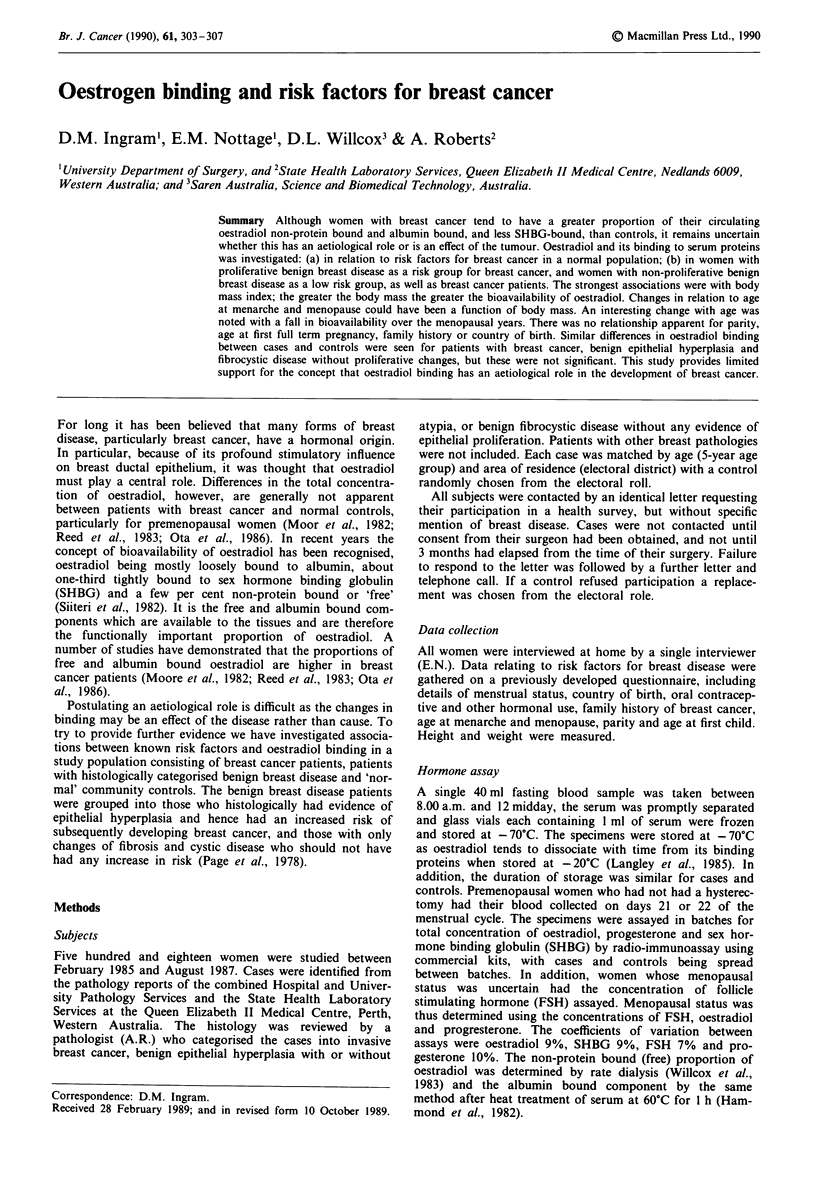
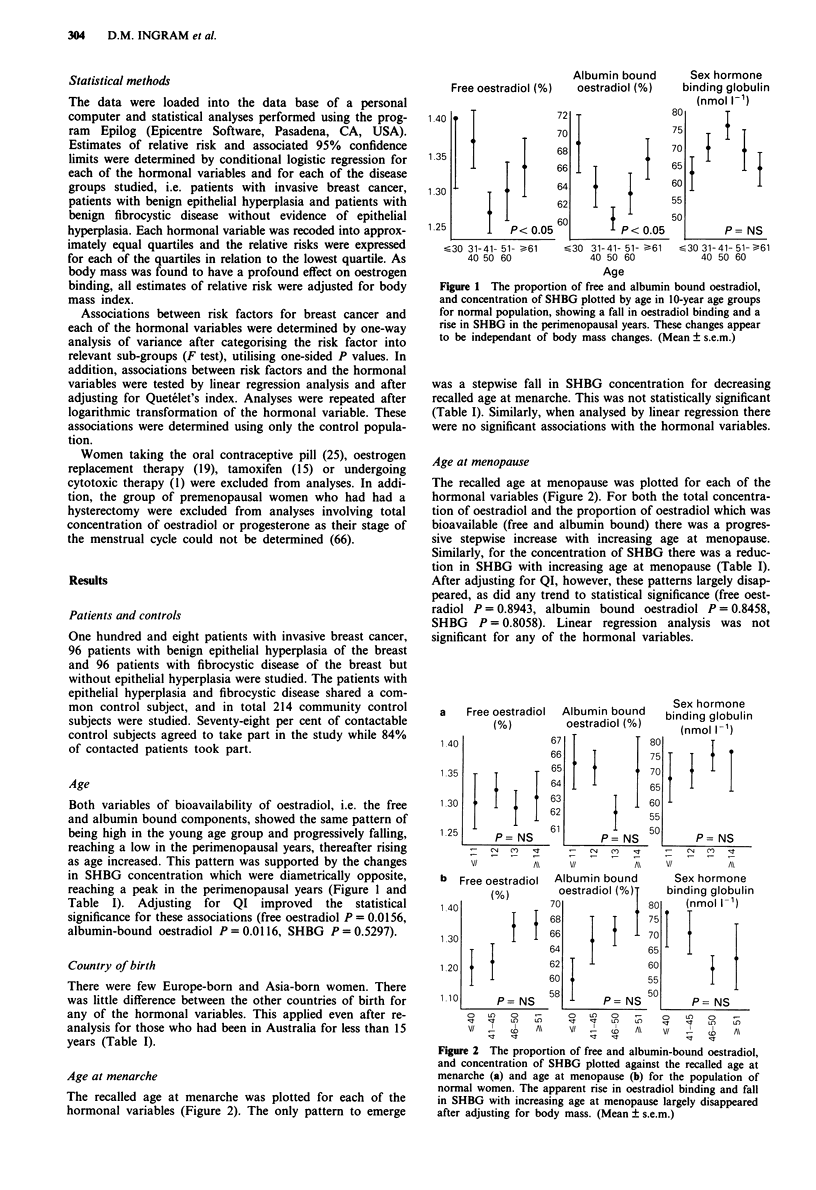
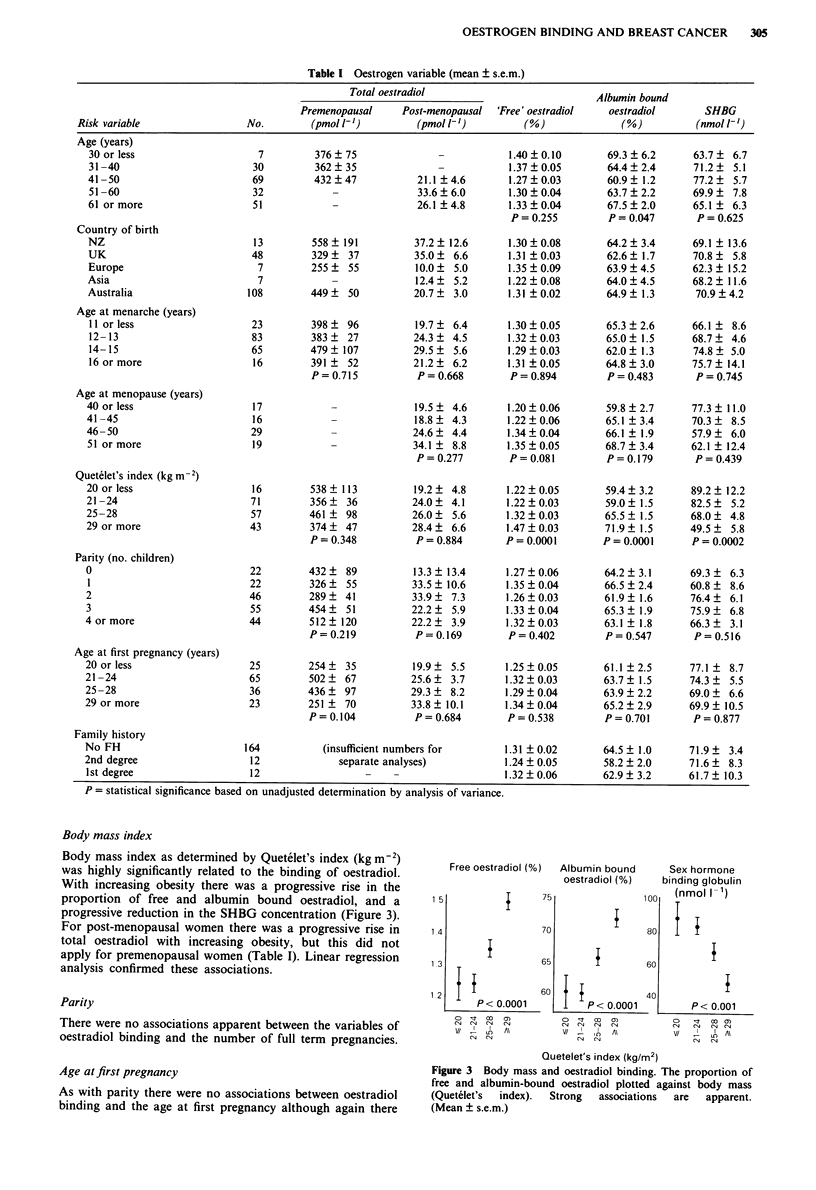
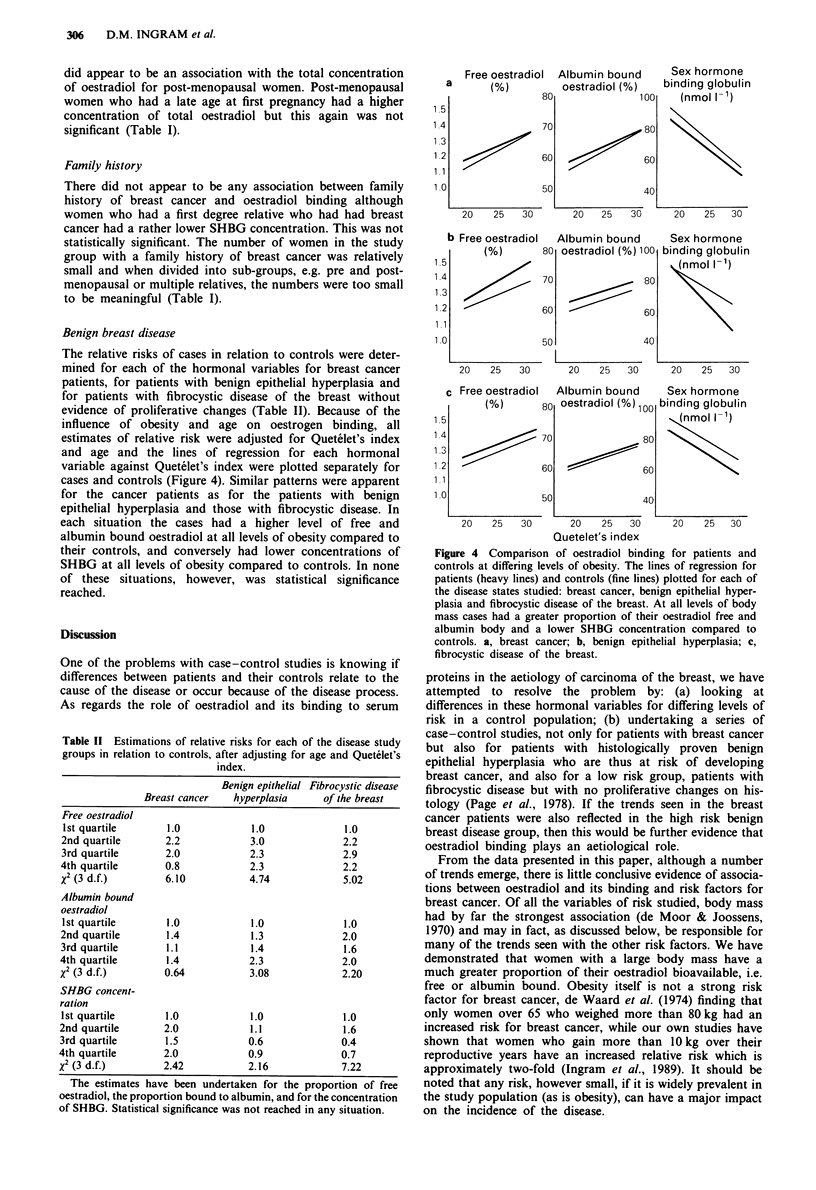
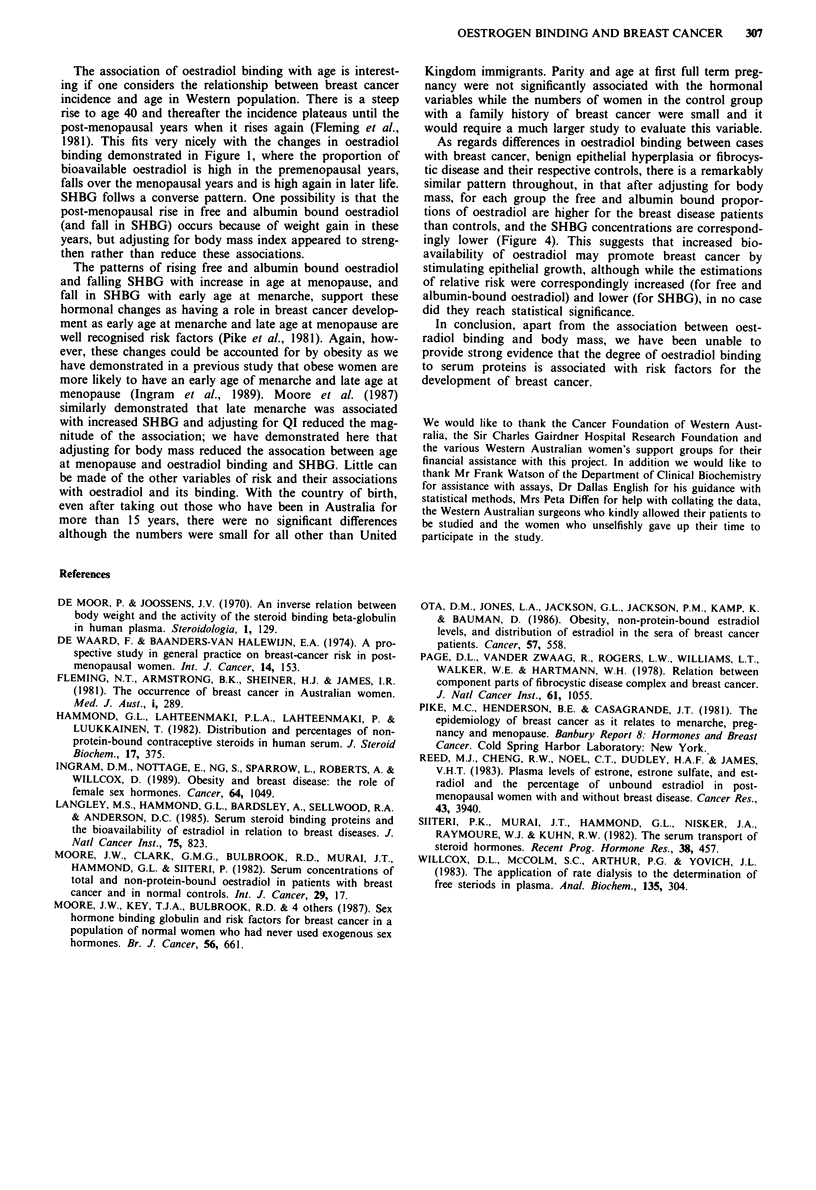
Selected References
These references are in PubMed. This may not be the complete list of references from this article.
- Fleming N. T., Armstrong B. K., Sheiner H. J., James I. R. Occurrence of breast cancer in Australian women. Med J Aust. 1981 Mar 21;1(6):289–293. doi: 10.5694/j.1326-5377.1981.tb135577.x. [DOI] [PubMed] [Google Scholar]
- Hammond G. L., Lähteenmäki P. L., Lähteenmäki P., Luukkainen T. Distribution and percentages of non-protein bound contraceptive steroids in human serum. J Steroid Biochem. 1982 Oct;17(4):375–380. doi: 10.1016/0022-4731(82)90629-x. [DOI] [PubMed] [Google Scholar]
- Ingram D., Nottage E., Ng S., Sparrow L., Roberts A., Willcox D. Obesity and breast disease. The role of the female sex hormones. Cancer. 1989 Sep 1;64(5):1049–1053. doi: 10.1002/1097-0142(19890901)64:5<1049::aid-cncr2820640515>3.0.co;2-m. [DOI] [PubMed] [Google Scholar]
- Langley M. S., Hammond G. L., Bardsley A., Sellwood R. A., Anderson D. C. Serum steroid binding proteins and the bioavailability of estradiol in relation to breast diseases. J Natl Cancer Inst. 1985 Nov;75(5):823–829. doi: 10.1093/jnci/75.5.823. [DOI] [PubMed] [Google Scholar]
- Moore J. W., Clark G. M., Bulbrook R. D., Hayward J. L., Murai J. T., Hammond G. L., Siiteri P. K. Serum concentrations of total and non-protein-bound oestradiol in patients with breast cancer and in normal controls. Int J Cancer. 1982 Jan 15;29(1):17–21. doi: 10.1002/ijc.2910290105. [DOI] [PubMed] [Google Scholar]
- Moore J. W., Key T. J., Bulbrook R. D., Clark G. M., Allen D. S., Wang D. Y., Pike M. C. Sex hormone binding globulin and risk factors for breast cancer in a population of normal women who had never used exogenous sex hormones. Br J Cancer. 1987 Nov;56(5):661–666. doi: 10.1038/bjc.1987.262. [DOI] [PMC free article] [PubMed] [Google Scholar]
- Ota D. M., Jones L. A., Jackson G. L., Jackson P. M., Kemp K., Bauman D. Obesity, non-protein-bound estradiol levels, and distribution of estradiol in the sera of breast cancer patients. Cancer. 1986 Feb 1;57(3):558–562. doi: 10.1002/1097-0142(19860201)57:3<558::aid-cncr2820570326>3.0.co;2-1. [DOI] [PubMed] [Google Scholar]
- Page D. L., Vander Zwaag R., Rogers L. W., Williams L. T., Walker W. E., Hartmann W. H. Relation between component parts of fibrocystic disease complex and breast cancer. J Natl Cancer Inst. 1978 Oct;61(4):1055–1063. [PubMed] [Google Scholar]
- Reed M. J., Cheng R. W., Noel C. T., Dudley H. A., James V. H. Plasma levels of estrone, estrone sulfate, and estradiol and the percentage of unbound estradiol in postmenopausal women with and without breast disease. Cancer Res. 1983 Aug;43(8):3940–3943. [PubMed] [Google Scholar]
- Siiteri P. K., Murai J. T., Hammond G. L., Nisker J. A., Raymoure W. J., Kuhn R. W. The serum transport of steroid hormones. Recent Prog Horm Res. 1982;38:457–510. doi: 10.1016/b978-0-12-571138-8.50016-0. [DOI] [PubMed] [Google Scholar]
- Willcox D. L., McColm S. C., Arthur P. G., Yovich J. L. The application of rate dialysis to the determination of free steroids in plasma. Anal Biochem. 1983 Dec;135(2):304–311. doi: 10.1016/0003-2697(83)90687-5. [DOI] [PubMed] [Google Scholar]
- de Moor P., Joossens J. V. An inverse relation between body weight and the activity of the steroid binding -globulin in human plasma. Steroidologia. 1970;1(3):129–136. [PubMed] [Google Scholar]
- de Waard F., Baanders-van Halewijn E. A. A prospective study in general practice on breast-cancer risk in postmenopausal women. Int J Cancer. 1974 Aug 15;14(2):153–160. doi: 10.1002/ijc.2910140203. [DOI] [PubMed] [Google Scholar]


